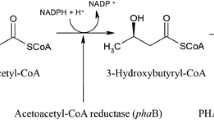Abstract
Three strains of the phototrophic purple nonsulfur bacteriumRhodopseudomonas palustris were isolated from different environments and were evaluated for their aromatic degradative potential under phototrophic conditions. All three strains (PFR1, PNR4, and MRL1) utilized benzoate, 4-hydroxybenzoate, 4-aminobenzoate, 4-aminophenol, cinnamate, ferulate, phloroglucinol, and 4-dimethylaminobenzaldehyde in the absence of exogenous CO2. 4-Aminobenzoate and 4-aminophenol served as a carbon and nitrogen source for all the three strains. Utilization of 4-aminophenol was enhanced in the presence of 4-hydroxybenzoate. Salicylate was utilized by PFR1 and MRL1 strains, and phenol was utilized by the MRL1 strain only in the presence of exogenous CO2.
Similar content being viewed by others
Literature Cited
Berry DF, Francis AJ, Bollag JM (1987) Microbial metabolism of homocyclic and heterocyclic aromatic compounds under anaerobic conditions. Microbiol Rev 51:43–59
Braun K, Gibson DT (1984) Anaerobic degradation of 2-aminobenzoate (anthranilic acid) by denitrifying bacteria. Appl Environ Microbiol 48:102–107
Dagley S (1971) Catabolism of aromatic compounds by microorganisms. Adv Microb Physiol 6:1–46
Dutton PL, Evans WC (1969) The metabolism of aromatic compounds byRhodopseudomonas palustris. Biochem J 113:525–536
Evans WC, Fuchs G (1988) Anaerobic degradation of aromatic compounds. Annu Rev Microbiol 42:289–317
Harwood CS, Gibson J (1988) Anaerobic and aerobic metabolism of diverse aromatic compounds by the photosynthetic bacteriumRhodopseudomonas palustris. Appl Environ Microbiol 54:712–717
Hegeman GD (1967) The metabolism ofp-hydroxybenzoate byRhodopseudomonas palustris and its regulation. Arch Microbiol 59:143–148
Imhoff JF (1988) Anoxygenic phototrophic bacteria. In: Austin B (ed) Methods in aquatic bacteriology. New York: John Wiley & Sons, pp 207–240
Imhoff JF, Truper HG (1989) Purple nonsulfur bacteria. In: Staley JT, Bryant MP, Pfennig N, Holt JG (eds) Bergey's manual of systematic bacteriology, Vol. 3. Baltimore: The Williams and Wilkins Co., pp 1658–1682
Kamal VS, Wyndham RC (1990) Anaerobic phototrophic metabolism of 3-chlorobenzoate byRhodopseudomonas palustris WS 17. Appl Environ Microbiol 56:3871–3873
Lowry OH, Rosebrough NJ, Farr AL, Randall RS (1951) Protein measurement with the Folin phenol reagent. J Biol Chem 193:265–275
Madigan MT, Gest H (1979) Growth of the photosynthetic bacteriumRhodopseudomonas capsulata chemoautotrophically in darkness with H2 as the energy source. J Bacteriol 137:524–530
Madigan MT, Gest H (1988) Selective enrichment and isolation ofRhodopseudomonas palustris usingtrans-cinnamic acid as sole carbon source. FEMS Microbiol Ecol 53:53–58
Patel TR, Jure KG, Jones GA (1981) Catabolism of phloroglucinol by the rumen anaerobeCoprococcus. Appl Environ Microbiol 42:1010–1017
Sleat R, Robinson JP (1984) The bacteriology of anaerobic degradation of aromatic compounds. J Appl Bacteriol 57:381–394
Tanaka H, Maeda H, Suzuki H, Kamibayashi A, Tonomura K (1982) The metabolism of thiophene-2-carboxylate by a photosynthetic bacterium. Agric Biol Chem 46:1429–1438
Truper HG, Pfenning N (1981) Characterization and identification of the anoxygenic phototrophic bacteria. In: Starr MF, Stolp H, Truper HG, Balows A, Schlegel HG (eds) The prokaryotes—a hand book on habitats, isolation and identification of bacteria, Vol 1. New York: Springer-Verlag, pp 299–312
Tsai DG, Jones GA (1975) Isolation and identification of rumen bacteria capable of anaerobic phloroglucinol degradation. Can J Microbiol 21:794–801
Whittle PJ, Lunt DO, Evans WC (1976) Anaerobic photometabolism of aromatic compounds byRhodopseudomonas sp. Biochem Soc Trans 4:490–491
Wright GE, Madigan MT (1991) Photocatabolism of aromatic compounds by the phototrophic purple bacteriumRhodomicrobium vannielii. Appl Environ Microbiol 57:2069–2073
Ziegler K, Braun K, Bockler A, Fuchs G (1987) Studies on the anaerobic degradation of benzoic acid and 2-aminobenzoic acid by a denitrifyingPseudomonas strain. Arch Microbiol 149:62–69
Author information
Authors and Affiliations
Rights and permissions
About this article
Cite this article
Khanna, P., Rajkumar, B. & Jothikumar, N. Anoxygenic degradation of aromatic substances byRhodopseudomonas palustris . Current Microbiology 25, 63–67 (1992). https://doi.org/10.1007/BF01570961
Issue Date:
DOI: https://doi.org/10.1007/BF01570961




